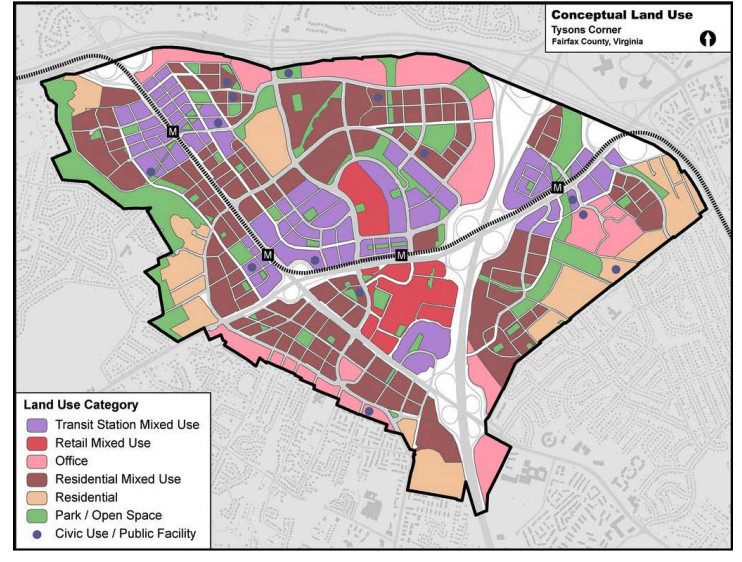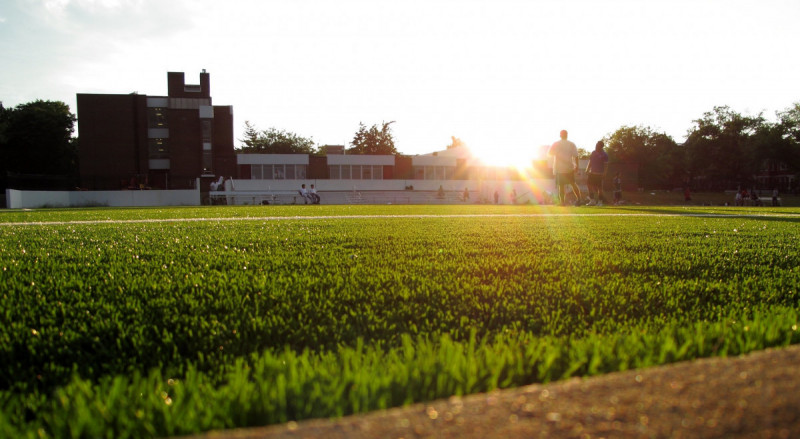How substantial park requirements may challenge walkability goals in Tysons

An athletic field by JonRidinger licensed under Creative Commons.
As part of the redevelopment plan for Tysons, Fairfax County implemented requirements for developers to provide athletic fields and other parks. The plan calls for 154 acres of park space in a planning area that’s about 2,500 acres in total. The plan specifically requires one full-sized athletic field for every 4.5 million square feet of new development, or an estimated 20 fields by 2050.
Access to green space plays a key part of making dense urban areas pleasant, but the focus on a large quantity of parks in the Tysons planning area poses a challenge for achieving walkability goals.
Parks played an unusually prominent part in the debate over whether and how new development in Tysons should be permitted. Homeowners and officials representing the neighborhoods surrounding Tysons focused on concerns that new residents in Tysons would use parks in other parts of the County, reducing their availability for residents living outside of Tysons. A board member of the McLean Citizens Association said of Tysons residents using parks in neighboring McLean:
“We cannot serve the needs of Tysons unless our quality of life is diminished significantly. We simply cannot accept that result.”
A land use map in Tysons including park and green space. Image from the Tysons 2018-2019 Progress Report on the Implementation of the Comprehensive Plan 
The Tysons plan calls for all of the park space that the plan requires, including 20 fields, to be built within the Tysons planning area rather than in other, less dense parts of the county where land is at less of a premium and walkability is less of a priority. McLean Citizens Association representatives have pushed for this requirement to be enforced (pages 9-10), citing concerns that locating new fields outside of Tysons would generate traffic from Tysons residents driving to them.
In addition to constituents concerned about new Tysons residents using parks in existing suburban neighborhoods, environmentalists (page 25) involved in crafting recommendations for Tysons redevelopment supported extensive green space to improve stormwater runoff management.
As of the county’s last progress report (pages 53-8) on development in Tysons, three athletic fields have been built. Developers have promised seven more fields, and more than 50 acres of additional park space have been delivered or proffered.
The Tysons plan frames extensive park space as a positive for nearly all stakeholders. But more parks aren’t always better. One of the key objectives of the plan for redevelopment in Tysons prioritizes walkability:
A key ingredient for transforming Tysons is to strategically use intensity to maximize the benefits of Metrorail and transit and to create sustainable, walkable urban environments.
Parks can contribute to achieving this goal when they themselves are destinations that draw pedestrians to them. However, when individual parks are not well-used because parks are too numerous, or when they’re boring expanses to walk past, they harm neighborhood walkability by increasing the distance walkers must travel between other destinations.
Requirements for lots of parks — particularly requirements for athletic fields — are in tension with the walkability goals for Tysons’ redevelopment. Parks can create what urban theorist Jane Jacobs called “border vacuums.” Border vacuums are long stretches of monotonous space separating potential destinations. They can include train tracks, large buildings with boring facades, and parks.
Meridian Hill Park in Columbia Heights by Joe Flood licensed under Creative Commons.
Athletic fields are particularly likely to create border vacuums. Consider two parks in Columbia Heights, one of the region’s most walkable neighborhoods. Meridian Hill Park draws in people of all ages for many different purposes, from adult soccer games, to family picnics, to young children learning to ride bikes. Meridian Hill Park is walled, a strong border vacuum characteristic, but it’s so well-designed and serves so many different users during all daylight hours that (at least in this pedestrian’s opinion), it avoids being a border vacuum. It’s many ornate entrances pull walkers along visually.
Tubman Elementary School field in Columbia Heights. Image by Mr.TinDC licensed under Creative Commons.
Contrast this with the field behind Tubman Elementary School. This field is about as active as an athletic field can be, used for recess along with regular soccer, bocce, and other sports games on evenings and weekends. But still, the field represents a break in pleasant walkability along 11th St NW. It requires walkers to pass an entire block of grass, which has no visual interest when a game isn’t going on.
This isn’t to say that large athletic fields have no place in walkable neighborhoods, but their quantity and placement must be considered carefully since they come at a cost to walkability. As Jacobs put it, “Greatly loved neighborhood parks benefit from a certain rarity value.”
In most urban areas, local governments build and manage park space directly. But the Tysons plan relies on developers to proffer park space as a condition of being allowed to build there. This approach has advantages and disadvantages for delivering quality public space. It takes advantage of property owners’ incentives to create environments that will draw people to their space; however, if the plan requires too much public space, it risks public space provision being a box checking exercise for developers instead.
In mandating that developers provide parks and civic space, the Tysons Comprehensive Plan is following in the footsteps of New York City. In 1958 the Seagram Building opened, featuring a public plaza that quickly became a favorite spot for Midtown workers to eat lunch or spend breaks outside. Following the plaza’s success, the New York City began a density bonus program that allows developers to build more densely if they provide “privately owned public space.”
Because these public spaces were built to meet the requirements for bonus density rather than to improve buildings’ value, they generally have not proved as appealing as the Seagram Building’s plaza (page 322-31).
So far some of Tysons’ new public spaces are serving residents well. The Plaza outside of Tysons Corner Center serves as an all-ages gathering space. One of the athletic fields that’s open so far abuts the Beltway where walkability is likely impossible with or without an additional border vacuum. But as park space is required to become much more prevalent, Tysons may find that its requirements stand in the way of walkability and well-loved public space.
